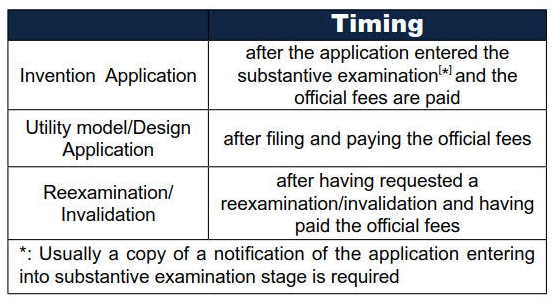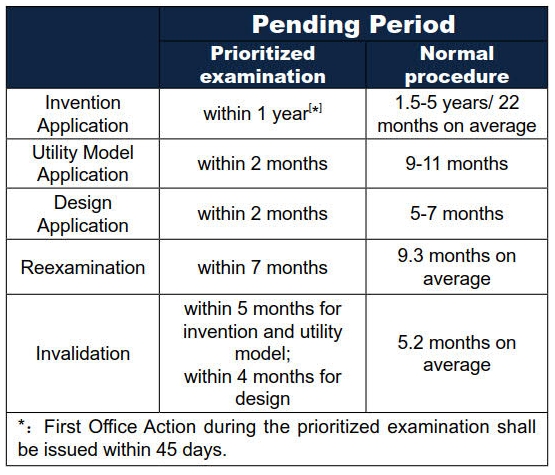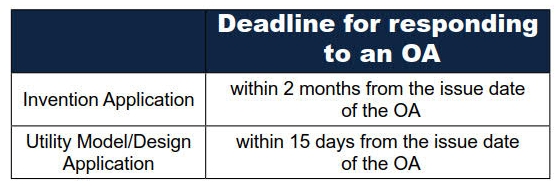 |
Author: HE,Ziqiu |
|
|
|
Patent Attorney |
|
New “Administrative Measures for Prioritized Patent Examination” (herein after the “Measures”) were issued on August 1, 2017 by CNIPA, to replace the old Measures issued in 2012 which were only applicable to the expedition for invention patent application.
The new “Measures” enhance its applicability in many aspects, simplify the administrative procedures, and are believed to be a more efficient way to meet the increasing demand for expediting the examinations of patent applications, reexaminations and invalidation cases. The following will provide an overview of these “Measures”.
Eligible circumstances
I).A request for prioritized examination can be filed for the cases undergoing examination or reexamination procedures for all the three types of patent application in China (i.e. invention, utility model and design application), as long as the cases satisfy at least one of the following conditions as prescribed in Article 3 of the “Measures”:
1).relating to energy conservation, environmental protection, new-generation information technology, biology, high-end equipment manufacturing, new energy, new materials, new energy vehicles, intelligent manufacturing and other key national industries;
2).relating to the key industries encouraged and supported by the governments at provincial level and municipal level;
3).relating to internet, big data, and cloud computing, in which fields technologies and products follow a rapid update rate;
4).cases which are ready for implementation or have already been implemented by the patent applicants or reexamination petitioners, or those with evidence proving that others are implementing the invention;
5).cases which are first-time applied in China and then filed in other countries or regions with the same subject matters;
6).other matters that are of great significance to national interests or public interests and require prioritized examination.
II).A request for prioritized examination can be filed for the invalidation cases as long as the cases satisfy at least one of the following conditions as prescribed in Article 4 of the “Measures”:
1).the parties have filed a request with local IP offices for enforcement, filed litigation before courts or filed an arbitration application before arbitration mediation organizations, for infringement disputes concerning the patent at issue,
2).the patent at issue is of great significance to national interests or public interests.
To justify that a case falls within the above eligible circumstances,relevant documents need to be submitted along with the request, such as,
■ documents showing that the application belongs to a key development industry or a rapid developing technology etc. as prescribed by relevant government guidance catalogues,
■ materials concerning prior arts or prior designs,
■ relevant supporting documents, such as photos, catalogs,and manuals, sale contracts, supply agreements, and purchase invoices etc. of the relevant product,
■ documents on the on-going implementation of the invention or on the potential infringement behavior,
■ recommendations made by relevant department of the State Council or an intellectual property office at provincial level.
Recommendations are often required, except for item 5) of Article 3 as mentioned above and for a patent reexamination case that had been previously preceded with priority examination. That is, once a case has been examined under a prioritized examination procedure,no recommendation opinions are not required with the request for prioritized examination on its reexamination.
Parties and timing to make the request
As prescribed in the “Measure”, a prioritized examination can be requested by:
■ patent applicant(s) during prosecution of patent application, i.e. during examination and reexamination procedure for patent application;
■ all patentee(s) or all petitioner(s) for invalidation case;
■ local IP offices, people’s courts or arbitration mediation organizations handling an infringement dispute for invalidation cases.

Time limits set for prioritized examination
As compared with the pending period of normal procedures which mainly depends on the efficiency of the examiner and the applicant,the “Measures” draws strict time limits for the prioritized examination for all types of procedures, as shown in the following table. The prioritized examination will be strictly performed by CNIPA, and thus will greatly shorten the related pending period.

For prioritized examination on patent applications, to guarantee the strict time limits, the applicant is required to submit very fast responses to any office action according to the deadlines as shown in the following table.

The deadline for response in the prioritized examination is calculated from the issue date of an OA, i.e. the date printed on the office action, which is different from the calculation of a response deadline in the normal procedure, in which case it is calculated with an addition of a mailing period of 15 days from the issue date of an OA. Thus, intense monitoring and fast reaction to any OA shall be conducted for the cases involving prioritized examination.
For reexamination and invalidation cases, there is no such provisions regarding the time limit for submitting a response.
Conditions causing a cease of prioritized examination
The “Measures” also set certain conditions under which CNIPA, may cease the procedures of prioritized examination, and handle it under the normal procedures, respectively for patent application and reexamination/invalidation cases.
For patent application, conditions causing a cease of prioritized examination are:
1).the applicant submits amendments to the application document under Article 51.1 and Article 51.2 of the Implementation Regulations of the Chinese Patent Law after the request for prioritized examination is approved;
2).the applicant makes a response exceeding the time limits specified and prescribed as above;
3).the applicant files fraudulent materials;
4).the application is found during the prosecution to be an abnormal patent application.
For reexamination/ Invalidation cases, Conditions causing a cease of prioritized examination are:
1).the reexamination applicant requests an time extension for the reply;
2).the invalidation petitioner supplements evidences and reasoning after the request for prioritized examination is approved;
3).the patentee amends the claims by ways other than deletion after the request for prioritized examination is approved;
4).the procedures of patent reexamination or invalidation are suspended;
5).the trial of the case relies on the conclusion of other cases;
6).it is a complicated case, and the approval to cease prioritized examination is given by the director of the Patent Reexamination Board.
There is no official fee for prioritized examination, and currently, there is no limitation on how many times a request for prioritized examination can be made for one case, which is unlike the PPH request for which only two opportunities to file the request is allowed.
■ The “Measures” also prescribes that a request for prioritized examination cannot be applied to cases that have been accelerated according to other agreements/protocols. Such as, a case that has requested for a fast examination under PPH cannot request prioritized examination. Thus, the applicant should choose carefully among the two means for expediting examination based on the consideration of the differences between PPH and the prioritized examination regarding procedures and results.
■ For same-day applications, i.e., the applications for an invention patent and a utility model patent regarding the same invention filed on the same day, local IP authorities have different prescriptions regarding the conditions for the request of prioritized examination for the invention patent application, while there is no limitation on the request for prioritized examination for the corresponding utility model application.
■ For example, if same-day utility model application and invention application are filed, Beijing IP office does not allow for the request for prioritized examination for the invention application, Guangdong IP office does not allow for the request for prioritized examination for the invention application unless the utility model application is withdrawn or deemed as withdrawn, while Jiangsu IP office requires a copy of notification of granting a patent right for the utility model application (which means after granting a patent right of the utility model, request for prioritized examination for invention application can be made).
Above all, due to such different provisions by different IP authorities on same-day applications, careful consideration should be made on the filing of such same-day applications, and the choice regarding which of the application among the invention patent application and the utility model application shall be requested for prioritized examination should be made before their filings.
■ The amount of cases undergoing the prioritized examiner is determined by CNIPA, based on its examination capacity, the number of granted patents in the last year and the number of pending cases in the present year. That is to say, it is advised to file the request earlier in the year as the annual quota for a type of request might be reached.
■ Request for prioritized examination can be made for a divisional application.
By utilizing the “Measures”, the prosecution for applications will be significantly expedited following the strict timelines set in the “Measures”, which can be especially beneficial for cases in the pharmaceuticals industry. The “Measures” are a very good supplementary to the current patent system in China, providing a new choice for expediting examination procedures for important and valuable cases.



